Bonaire is an island renowned for its undersea world, most tourists assuming all the attraction is 60 feet down under, but the southern Caribbean island has a few surprises rising up from its coral rock. Between a National Park teeming with wading flamingos, snorkeling in crystalline cave waters, kayaking through mangrove forests, or simply searching for any of 200 bird species, Bonaire offers a plethora of enticing activities both above and below the waves. It’s here, after all, that the words “sustainable” and “conservation” held sway long before the concepts became fashionable. The fruits of the island’s efforts in those regards have resulted in pristine natural environments. Granted, the island’s claim to fame remains its scuba diving, as Bonaire has long been considered a diving Mecca with some of the healthiest reefs in the Western Hemisphere. But, when you’re tired of Disney-esque resorts and truly want to experience “island life”, Bonaire beckons. Worst case, if the pace is too slow, you can tour the rugged island on a Harley with refreshing trade winds easily clearing the stresses of over-civilization.
The Alphabet Islands
Bonaire is part of the ABC islands, as in Aruba, Bonaire and Curacao, a string of islands situated just north of Venezuela, safely below the “hurricane belt” making for a timely visit most any time of year. Part of the Netherlands for nearly 200 years, in 2010 Bonaire became an independent province, but in truth the island has long been an amalgamation of influences as evidenced by locals alternating seamlessly between Dutch, English, Papiamentu (a Creole language with African/Portuguese roots) and Spanish. There is evidence of nomadic inhabitance on the island from 1,400 B.C, after which time the Arawaks migrated from Venezuela to the island, followed by Europeans centuries later, the latter in turn bringing African slaves. Americans then brought their scuba divers to the isle in more recent times, and so on goes the colorful melting pot that is Bonaire. Now, the main aspect of Bonaire that remains distinctly Dutch is the island’s architecture with brightly colored shops as vibrant as fields of tulips, yet the currency to spend within them is the US dollar.
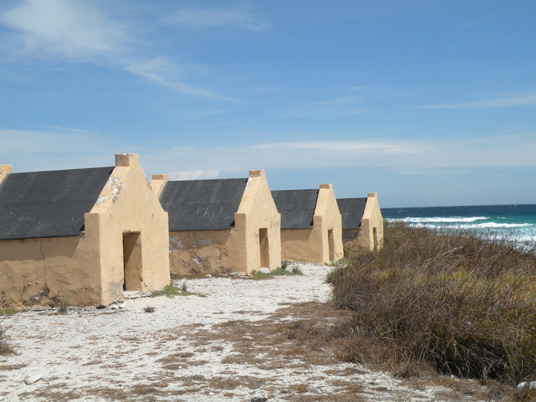
All in all, this kaleidoscope of countries and cultures creating the Bonaire of today has made for quite the “international” island — especially for one outside mainstream tourist consciousness. Mind you, Bonaire is not known for beautiful sandy beaches and in fact, those are far and few between. When visitors do stumble upon one, however, they can be stunning bits of paradise if only for 50 yards, but then, glorious seclusion requires yards not miles.
Must-Do’s of Bonaire
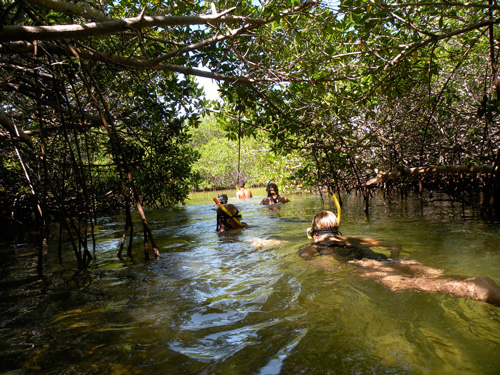
Though I belong to a large audience of divers that swoon over the richness of Bonaire’s reefs, on a recent visit to the island I decided to broaden my horizons and spend as much time topside as down under. As it turns out, I ran out of days before I ran through my must-do list. At the top of that list was Washington Slagbaai National Park, which spans the entire northern end of Bonaire, totaling nearly 14,000 acres. The skies of the park’s rugged, arid landscape are pierced with silhouettes of towering cactus, while land underfoot resembles a blackened moonscape, the coral cooked black in places by the scorching sun. Large pieces of driftwood are perched in barren spots of the national park, creating Ansel Adams-type scenery, though I wonder how anything could have “drifted” to areas obviously long ago forsaken by the seas.
Lizards dash at nearly every step as I hike the park’s austere but pretty trails. Then just when I think it can’t get any hotter, my fellow hikers and I stumble upon one of those glorious small beaches I mentioned, this one tucked in a horseshoe bay flanked by small cliffs. It appears as though a virgin beach, but for us plunging into its rolling surf. From there, we opt for touring the rest of the park by car as there’s a lot of ground to cover, the park taking about four hours to fully canvass; the time can be cut in half via a shortcut through the park’s middle. Along the winding roads (an oxymoron on some bumpy stretches), wild goats scamper about, an old lighthouse looms, and then suddenly upon one sharp turn, hundreds of pink flamingos brighten the desert-scape with vivid hues of pink. This is Slagbaai, a birder’s paradise with flamingos primping, pelicans yawning, and countless other birds darting in and out of the shallows. Opposite their feeding grounds are a few buildings where for a nominal fee, visitors can camp, the buildings fronting a beach with reefs that attracts both snorkelers and divers.
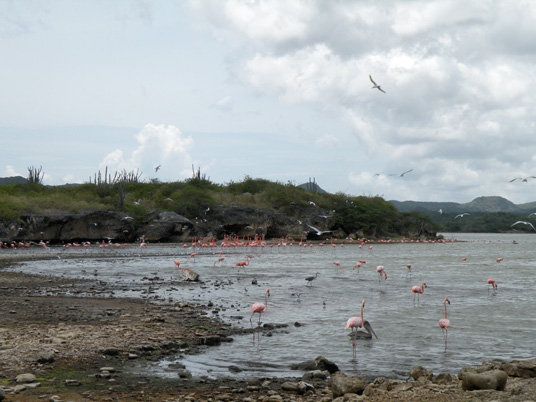
Have You Ever Tried Drinking a Cactus?
Just outside the park is Bonaire’s second largest city, Rincon, worthy of a stop for its cactus distillery. Yes, that’s right, a couple of creative entrepreneurs decided Bonaire needed its own “authentic” spirit, and so the island has become perhaps the only place in the world where a liqueur is culled from cactus, the Cadushy cactus. Far from being an oddity, the liqueur hints of margarita flavors smooth to the palette. The proprietors of the Cadushy Distillery, the Geitman’s from Holland, have not only begun exporting to other Caribbean regions, but soon expect to take their cactus liqueur worldwide as well as other locally inspired liqueurs such as one fermented from wild cherries and another from soursop fruit. The latter has the delicious, velvety subtleties of pineapple and coconut.
Heading south toward the middle of Bonaire is the capital, Kralendijk. There, restaurants and nightspots span the waterfront while quaint boutiques and other eateries dominate the side streets. Nearby is Museo Boneriano, a small quirky museum, interesting for its historical perspective on Bonaire with everything from archaeological artifacts to antiquated cooking devices and musical instruments from bygone eras carved from coral.
Two of my favorite restaurants in town are Zeezicht, for the Caribbean flair put into its seafood, and El Mundo (“The World”) with its wide-ranging international selections from Argentina and Austria, to Indonesia, Italy and of course, the Netherlands among others. It’s rare to see a dinner entree on the island much over $20, Bonaire being fairly affordable in that regard. As a local wise woman also noted, you could theoretically have a free drink every night of the week, or at least at vastly reduced prices, were you to map out the various hotel manager’s cocktail parties like at Captain Don’s Habitat on Mondays or Buddy’s Dive Resort on Fridays. Alternatively, for fine dining on the higher end of the scale is Tipsy Seagull, one of the prettiest of dining spots, at Plaza Resort Bonaire. Reserve a table in the sand under their tiki hut for your group of friends and dine in the glow of island lights flickering across the waves.
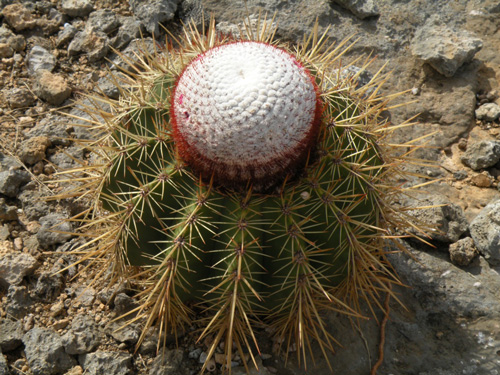
Salts of the Sea – Watery Expeditions
Rounding out Bonaire’s touring, the south end features a rugged, stone-strewn coast, its windswept beauty haunting, with waves crashing fiercely along the stretch called Piedra Pretu, meaning “black stone.” I can’t imagine how trading ships once plowed through the surf to retrieve the salt produced by African slaves relegated to live in small huts in the area. The abandoned huts still dot the coast, each a bare four by six feet or so in dimension, meant to house up to seven male slaves. The adjacent obelisks were coded with colors of the Dutch flag to let ships know the grade of the “wild gold”, as salt was known then, available at respective sites. Bringing the salt trade current and comprising Bonaire’s second biggest industry behind tourism, at the southern tip of the island is a vast area of salt ponds that systematically harvest the grain for export, the groomed piles resembling endless rows of small pyramids.
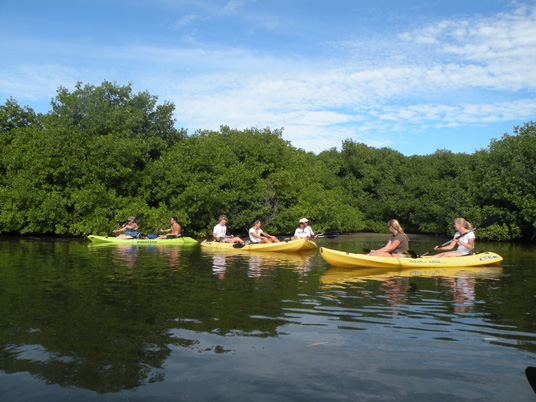
At the end of the day however, it’s the other salt of the sea that remains Bonaire’s biggest draw — the diving and water sports. Among the prettier excursions in that regard is a kayaking expedition where paddlers can disembark to snorkel amidst mangroves. With the sunlight streaming through the roots to illuminate these nurseries of the sea — spawning grounds for fish — it’s quite beautiful. Another unique, albeit somewhat challenging adventure, is to join small groups orchestrated by Jentis Tours, where visitors climb into the depths of a cave that features a pool of translucent water, and complete with flashlights, snorkel amidst stalagmites and stalactites for another stunning snorkeling adventure. Another popular adventure in the south is with Windsurf Place in Lac Bay offering lessons given by some of the Caribbean’s top champions. Lac Bay features nearly a mile of chest-high waters so fledgling windsurfers can safely test their mettle while non-windsurfing partners can enjoy lounging on the bay’s pretty beach.
Renowned Shore Diving
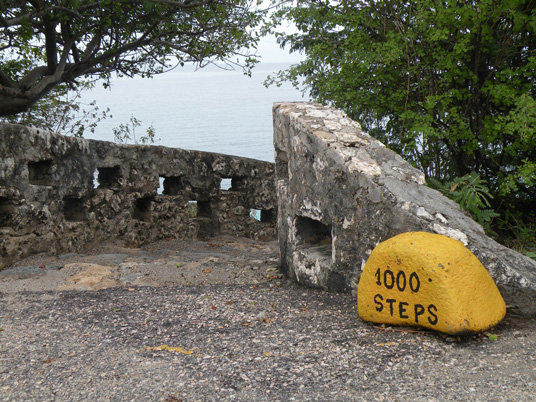
Then there’s Bonaire’s diving, which to many is the heart and soul of Bonaire. Just ask the legendary Captain Don Stewart who arrived in 1962. At that point, the Lieutenant Governor told him Bonaire would soon be involved in tourism. Captain Don replied that the island was “a rock” and questioned just what the Governor thought he was selling. As it turns out, it was Captain Don that spearheaded the island’s diving industry upon seeing the exquisite underwater aquarium just off its shores. He’d discover sites, hold celebrations to christen them, and over time, each became marked by a yellow stone at the road’s edge to let diver’s know where to enter the waters. There is now no place in the Caribbean more renowned for its “shore diving”, featuring gently sloping, plentiful reefs. All these areas are part of a National Marine Park, well protected to conserve Bonaire’s gem of tourism for decades to come.
There are now 89 official dive sites, which also includes those on Klein Bonaire, a deserted island within minutes reach by dive boat from the main island. But so popular is the chance for unlimited shore diving that one resort, Buddy’s Dive Resort, even has a drive-thru station to pick up tanks of air — like fast food but for the diving fanatic. Underwater, divers can see a plethora of coral formations, sea fans and sponges, a near endless amount of fish species, turtles and eels, with seahorses served up as a specialty of the Bonaire seas. The depth profile of most sites ranges from 30-100 feet. New to Bonaire in 2011 is also “DiveCaching”, like geocaching where GPS enthusiasts hunt for hidden caches from online coordinates, but in this case the small treasures are hidden in eco-friendly containers at dive sites. (Yes, I found one in between searching for seahorses!)
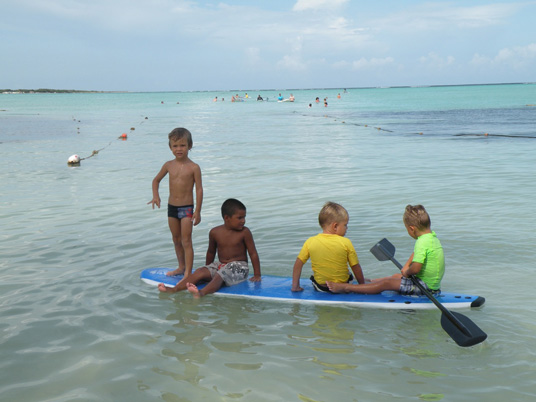
With so many unique attractions to observe above and below the island of Bonaire, it’s well worth plunging into a visit. The island may lack miles of white sandy shores, but it more than makes up for it with its rugged, natural beauty that has been so well preserved. Long before the term “eco-tourism” was coined, Bonaire was on to it. If defined by its natural bounty, for a relatively small island, Bonaire is one very rich nation.
[box bg=”#ccc”]
The area code for Bonaire is 599
Where to Stay
Captain Don’s Habitat — The first dedicated dive resort on Bonaire offering a casual atmosphere with spacious accommodations at ocean’s edge. Designed for low impact on the environmental surroundings. 103 Kaya Gob. N. Debrot, US phone 1-800-327-6709; local 717-8290, www.habitatbonaire.com
Buddy’s Dive Resort – There’s room to spread out with this resort’s one- to three-bedroom apartments. The resort also features a raised-sand beach, pool bar and famous drive-thru air fill station for divers. Kaya Gob. N. Debrot 85, tel: 717-5080. www.buddydive.com
Divi Flamingo Beach Resort & Casino — A sprawling and colorful full-service resort just minutes’ walk from town, featuring the island’s only casino. Facilities on-site are wheelchair accessible including the dive facilities. J.A. Abraham Blvd. 40, tel: 599-717-8285, www.diviresorts.com
KonTiki Beach Club — Popular with windsurfers given its location by Lac Bay, the spacious suites are also a bargain for families. Kaminda Sorobon 64, tel: 717-5369, www.kontikibonaire.com
Where to Eat
Zeezicht — Bright, airy setting along the capital’s waterfront with excellent seafood dishes. Kaya C. Craane 12, tel: 717-8434
El Mundo — Travel the globe with specialties at this international, open-air restaurant in town. Kaya Grandi 7, tel: 717-4601, www.elmundobonaire.com
Tipsy Seagull — Gorgeous beachside setting for fine dining under the stars. Plaza Resort Bonaire, tel: 717-2500, www.plazaresortbonaire.com
Maiky Snack — Lunch like a native with stewed goat, chicken and other inexpensive fare in an outback setting. Situated off the road to Lac at Kaminda Nieuw Amsterdam 30, tel: 700-6785.
What to See
Bonaire Marine Park — Get wet a little or a lot but by all means see some of the healthiest coral reefs in the Caribbean via snorkeling or diving. Reefs are within yards of most resorts, and boat diving is also available. Or, rent a car to access sites. With only a couple of main roads on the island, it’s almost impossible to get lost. Yellow roadside rocks denote dive sites for shore diving, some of which can also be snorkeled. Bonaire is one of the few places in the Caribbean where there’s a decent chance of seeing prized seahorses.
Washington Slagbaai National Park — 14,000 acre nature sanctuary for hiking, bird watching, diving and snorkeling, or for scenic (but bumpy) drives. A highlight is the Slagbaai area with its hundreds of wading flamingos. Also keep a lookout for the Caribbean Parakeet, wild goats and iguanas amidst pretty desert flora and fauna. Entrance area includes an interesting visitor’s center museum, tel: 788-9015, www.washingtonparkbonaire.com
Mangrove Kayaking/Snorkeling Tour — Take a leisurely kayak tour and disembark to snorkel amidst the mangroves, which serve as nurseries to the sea. Possibly one of the prettiest and most peaceful snorkel adventures ever. Excursions are guided by a naturalist. Tel: 780-5353, www.mangrovecenter.com
[/alert]

